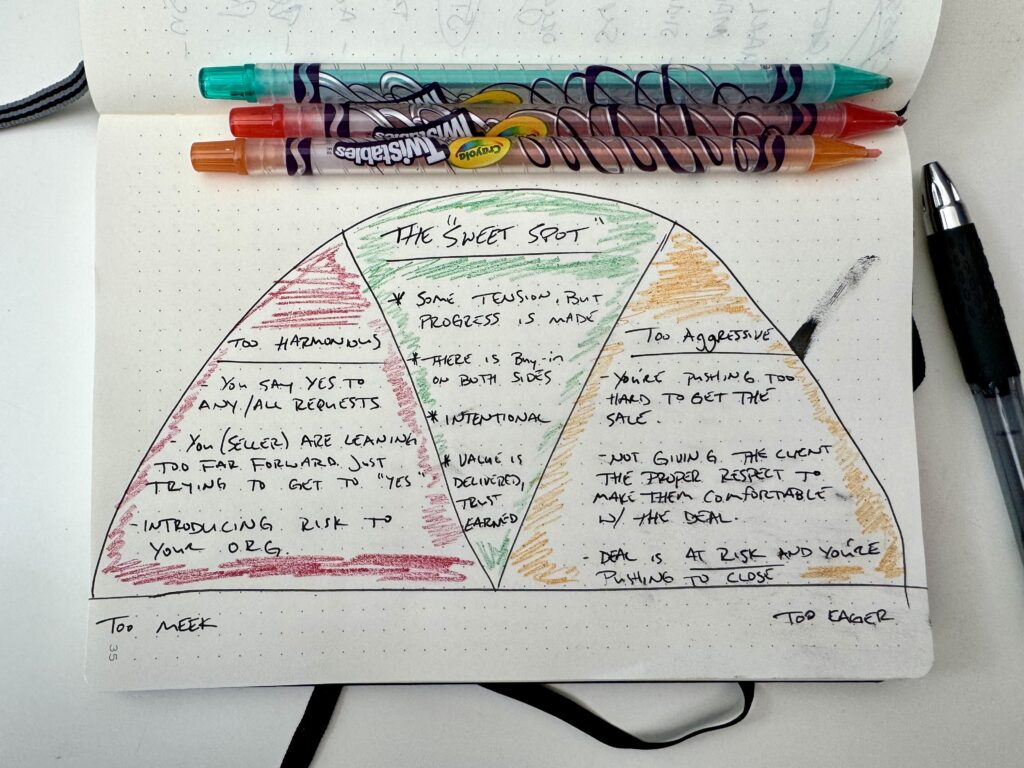B2B sales — particularly at the commercial and enterprise level — is as much art as it is science. It’s a strategic endeavor, a calculated motion, and in many cases a dance that requires finesse, intentionality, and a deep understanding of the rhythm of business dynamics. As sales leaders, our approach to selling and making deals must be as innovative and forward-thinking as the technologies we champion.
Time-To-Close Matters
When you’re working on a deal, time is not just a ticking clock; it’s what can build inertia or suffocate a deal. The adage “time kills all deals” is not just a cautionary tale; it’s a stark reality in the consulting world. The longer it takes to close a deal, the higher the risk of it disintegrating into the ether of lost opportunities. Swift, decisive action and the courage to move quickly towards a resolution is critical.
The Paradox of ‘No’
One of the most counterintuitive yet profoundly effective strategies in negotiation is the willingness to get to ‘no’ to ultimately arrive at ‘yes.’ It’s not about pessimism — it’s about pragmatism. By identifying deals that misalign with our core values and capabilities early on, we protect our resources from the draining endeavor of chasing ill-fitting opportunities. This allows us to focus on engagements that promise mutual growth and success, thereby turning potential losses into strategic gains.
The Path to ‘Yes’
So how do we navigate contract negotiations and get to “yes?” The journey begins with a deep dive into understanding who your Ideal Client Persona is. Without knowing your ICP, you may end up chasing the wrong prospects or going trying to sell to the wrong buyer or even into the wrong market segment.
Once you’ve found alignment on who you’re targeting and have initiated the sales conversation, it’s time to demonstrate value quickly. This not only accelerates the decision-making process but also builds a foundation of trust and credibility with potential clients.
Now, this can be a tricky scenario to manage — the balance between showing value to the client and delivering solutions before the deal is inked. Delivering value and strategy in pre-sales to build trust is OK, but don’t deliver operationally until contract signed and revenue is in the door. In other words, don’t go so far as to get the production or delivery team involved until a formal agreement is made.
Intentional Selling
In sales we need to tread the line between persistence and prudence. The eagerness to close a deal should never cloud our judgment about the fit and feasibility of a prospective engagement. The temptation to compromise on quality or terms to clinch a deal can be compelling, but such short-term gains can lead to long-term repercussions.
There are three modes in sales:
- The seller is too agreeable with the buyer. This typically means the seller is chasing the “yes” and is giving up too much in the process. It introduces risk into the organization if a deal is made with a misaligned buyer.
- The seller is too aggressive with the buyer. They’re pushing too hard to get the sale, not giving the client the proper respect to make them comfortable with the deal, and can put the sale at risk because they are pushing too much to make the sale.
- And finally is the sweet spot — where there is a healthy give and take between the buyer and the seller. Progress is being made to align the two parties, value is delivered, and trust is earned. This is where you want to be as a seller.

Beyond the Deal
Embracing an owner’s mindset in sales means thinking beyond the transactional nature of sales. It’s about seeking engagements that are not just profitable but also conducive to sustainable growth. This fiduciary responsibility towards our companies and ourselves mandates that we pursue deals that align with our strategic objectives and core competencies.
To excel in sales in high level B2B companies, your ability to discern who your ICP is, decide how to engage them, and how you deliver value will all impact your success.

